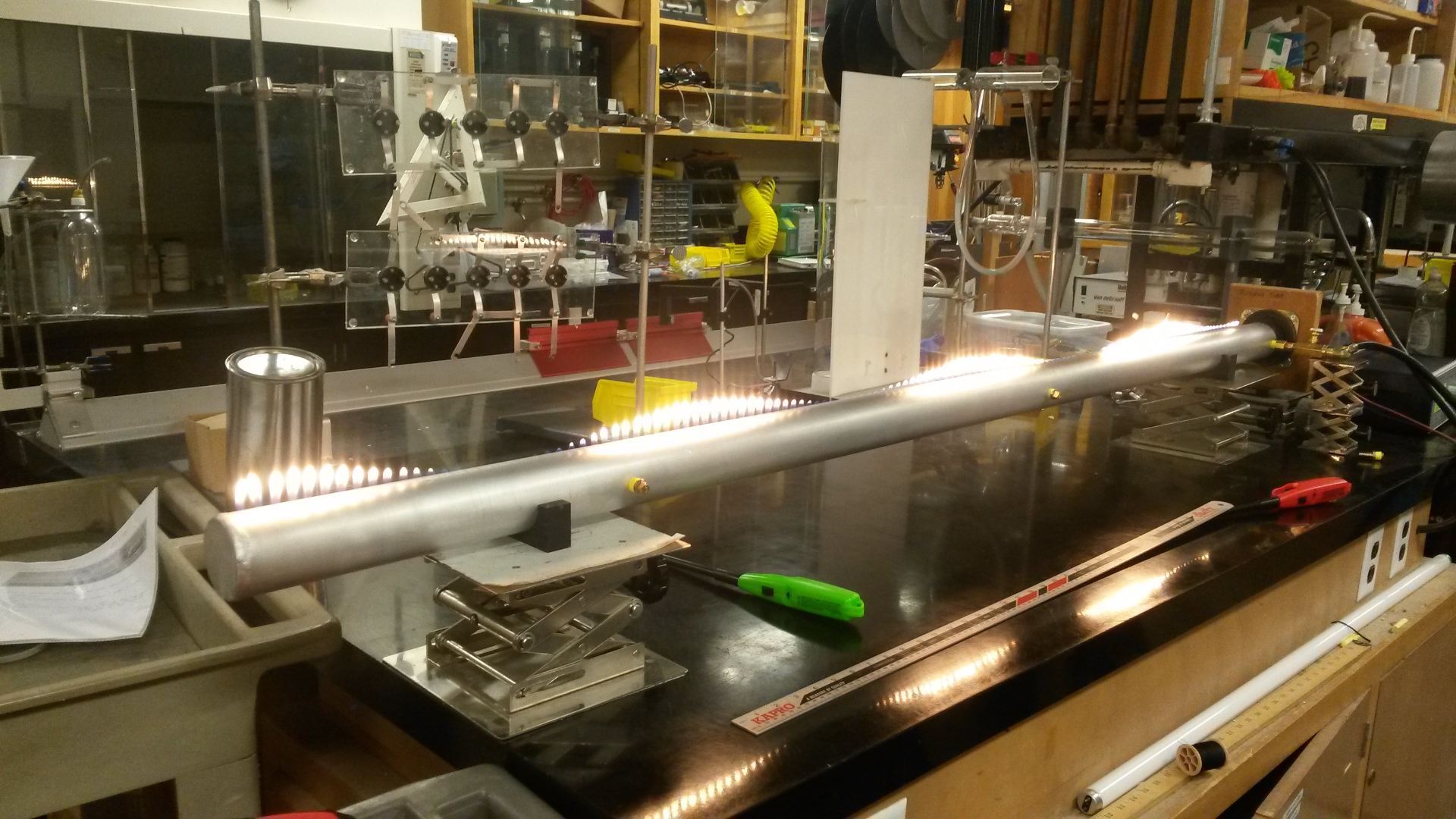The Rubens tube was created in 1905 by Heinrich Rubens and Otto Krigar-Menzel as a way to teach about acoustics. It could be called the first oscilloscope, illustrating sound waves through the use of a captivating light show.
Equipment:
- Rubens Tube [Above cabinet I]
- Rubens Tube Mounts [Above cabinet I]
- Propane Tank and Hose [Corner by monkey hunter]
- 2 Large Jack Stands
- 2 Small Jack stands
- Speaker
- Speaker stand
- Function Generator [Cabinet K1]
- Amplifier
- Auxiliary cord
- 2 Banana Cables with alligator clips on end [Below cabinet I]
- Meter Stick
- Fire Blanket
- Fire resistant Lab Coat [Below cabinet A]
- Fire extinguisher [Corner by monkey hunter]
Setup:
- Place Rubens tube on the large Jack stands with Rubens tube mounts.
- Use the little jack stands to prop up the speaker using the speaker mount and the fitting where the gas enters the Ruben Tube.
- Attach alligator clips to the two terminals on the back of the speaker.
- Plug the other ends of the banana cables into the amplifier or function generator.
- Place speaker so that the center of the speaker aligns with the center of the membrane. Place it as close to the membrane without touching.
- Last, attach the hose from the propane tank to the fitting on the Rubens tube.
Demo:
- Open the valve on the fitting of the Rubens tube.
- Open up the valve on the propane tank fully.
- Let the Rubens tube fill with gas before lighting.
- Light the Rubens Tube and use the valve on the fitting to adjust the flame height.
- Turn on the amplifier or frequency generator to see effects of standing waves.
Explanation:
The Rubens tube is a long aluminum pipe with one end closed off by a metal cap and the other capped with a silicone membrane. Going down the length of the pipe are 1/8″ holes that are spaced out every centimeter. On the side closest to the membrane there is a valve where propane gas can enter. At the end of the membrane a speaker is set up so that the speaker is centered with the membrane and placed as close as it can get without touching the membrane.
Once the pipe is filled with propane the gas can be lit to create a row of individual flames. The frequency generator can then be turned on and adjusted to see standing waves at different frequencies and resonances.
Longitudinal sound waves are variations in pressure rather than displacement and are often called pressure waves. The Rubens tube is closely related to an instrument like an organ which has one closed end. On the Rubens tube this end is the one with the metal cap. The end with the membrane is more or less an open end since it can fluctuate and the gas is free to move. The closed end there is always a displacement node and an antinode at the open end. Since the nearest antinode is 1/4λ, we can see that the fundamental or first harmonic corresponds to only one-fourth of a wavelength.
Ultimately the wavelength is equal to 4 times the length of the tube.
The fundamental frequency is thus:
This is exactly half for an open pipe of the same length. Also, another difference for a closed tube is that we only odd harmonics. So the overtones have frequencies that are 3,5,7,… times the fundamental frequency. There is no way to have the 2,4,6,… frequencies exist because there is always that antinode at the closed end of the tube.
The gas inside the tube follows the pressure wave and leaks out of the holes in a wave pattern. The flames appear to make wave patterns, depending on which holes are pumping out the most gas.
The tube can hold many different standing waves and as the more wavelengths are shown the wavelength gets smaller. Using the equation below we can measure the speed of the sound in the gas (c) versus its frequency and wavelength.
Where c is the speed of the sound in the medium (propane), f is the frequency coming out of the frequency generator, and lambda is the wavelength of the flames. Also, remember, this is a compression wave so from peak to peak, or trough to trough is .
When this calculation is performed the accurate speed of sound in propane is 258m/s.
Written by Nick McCabe
